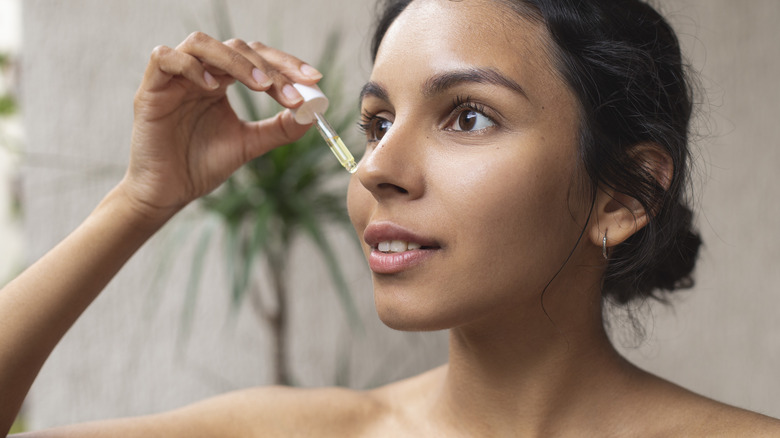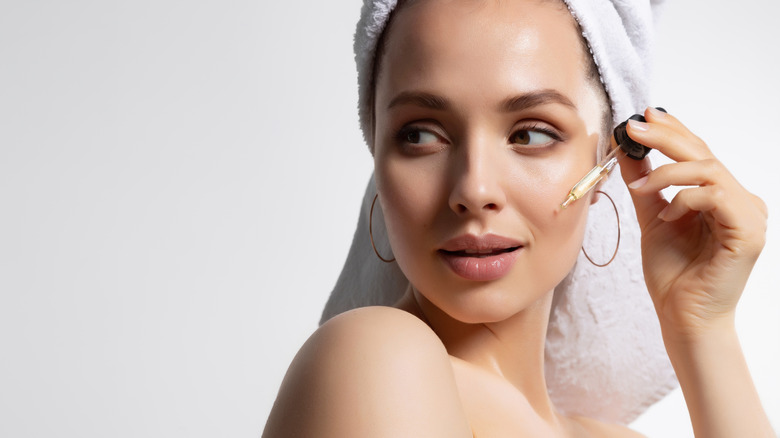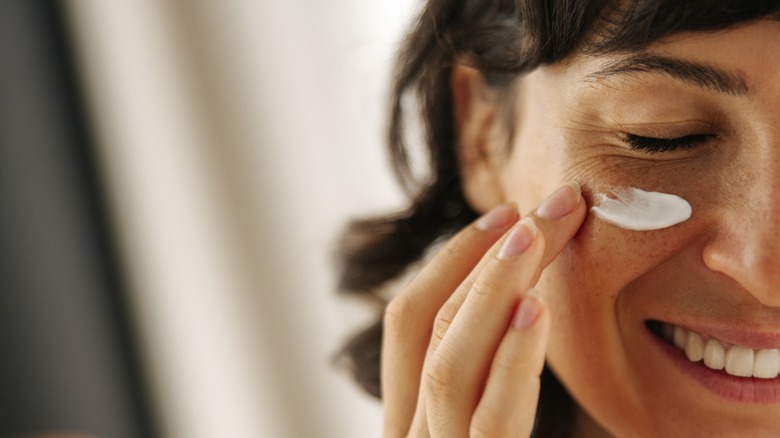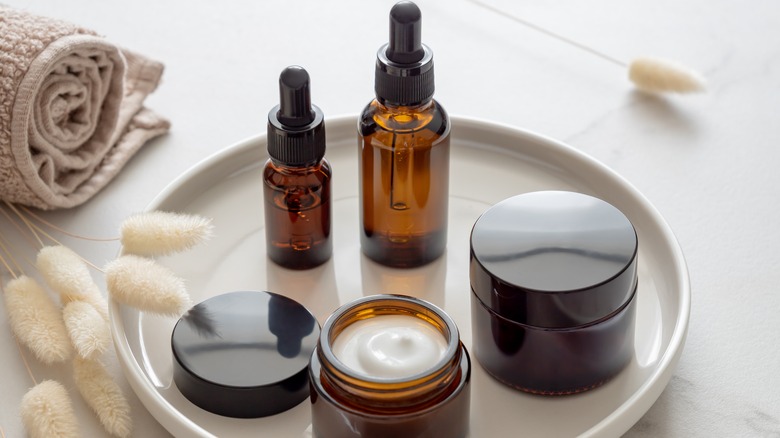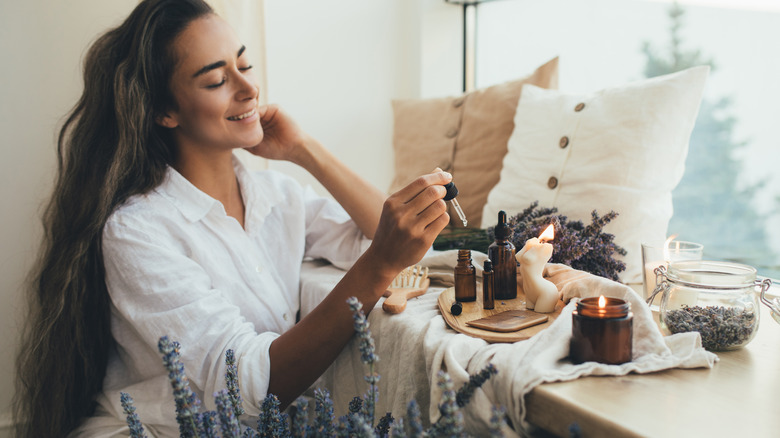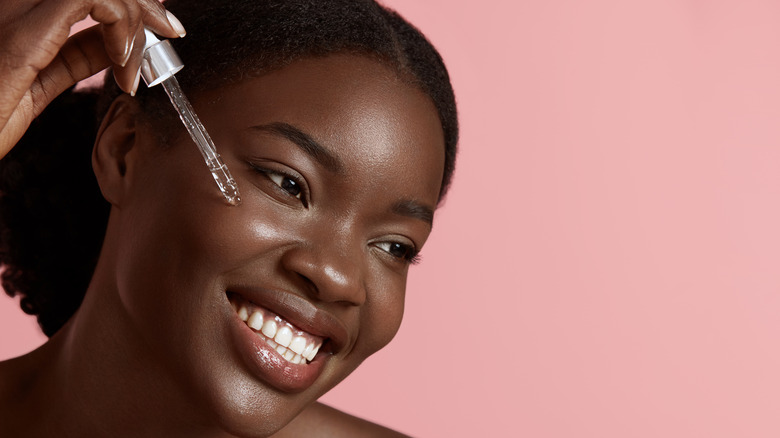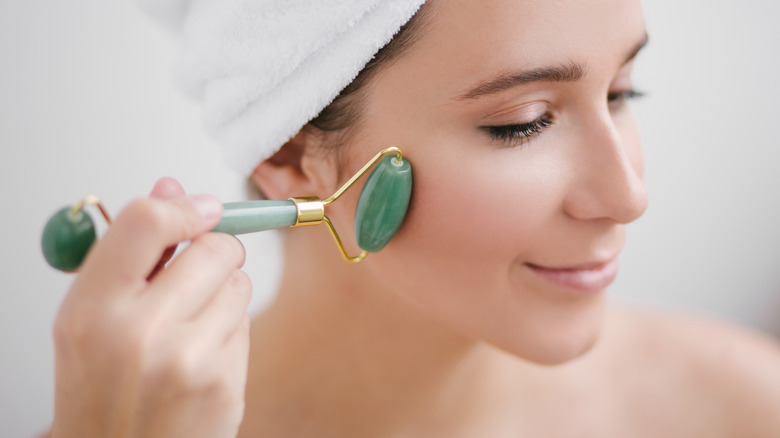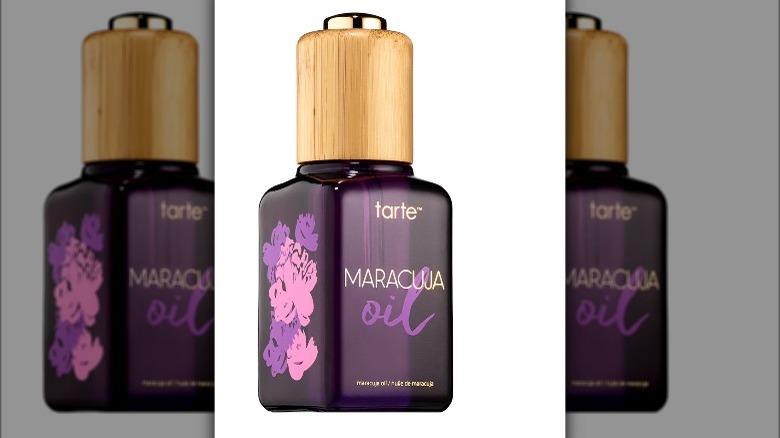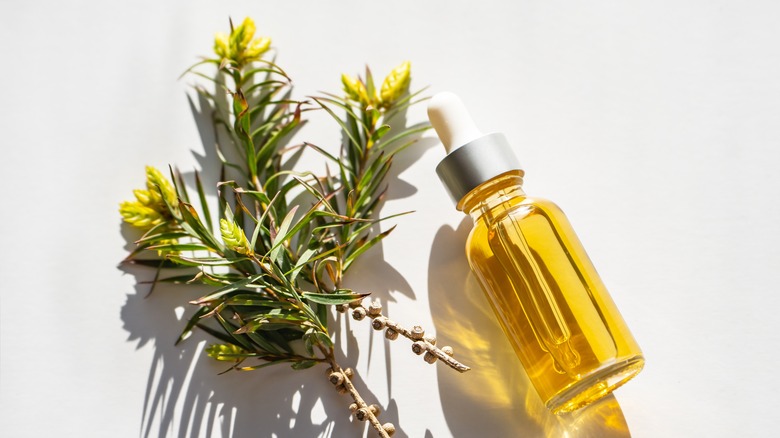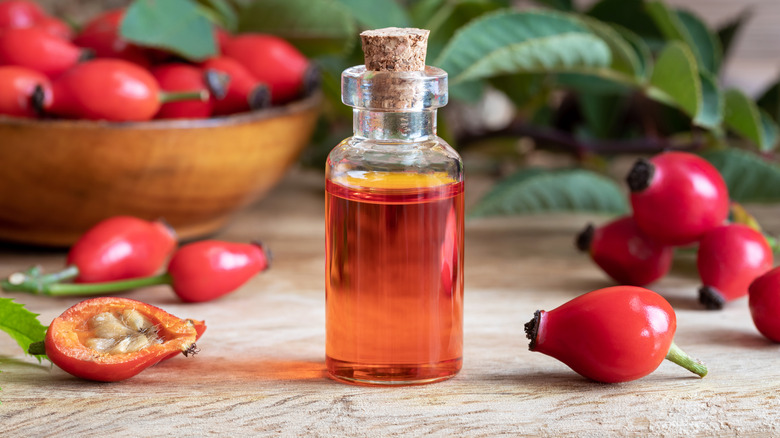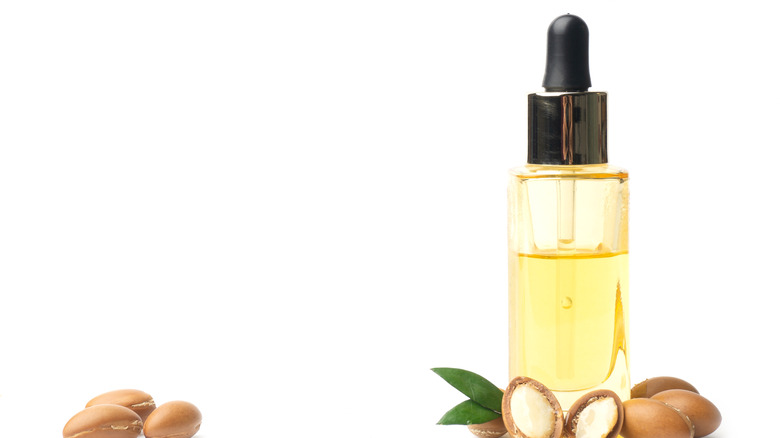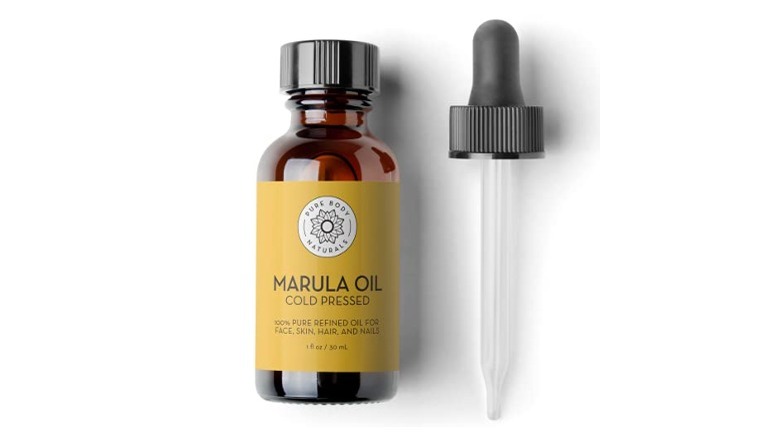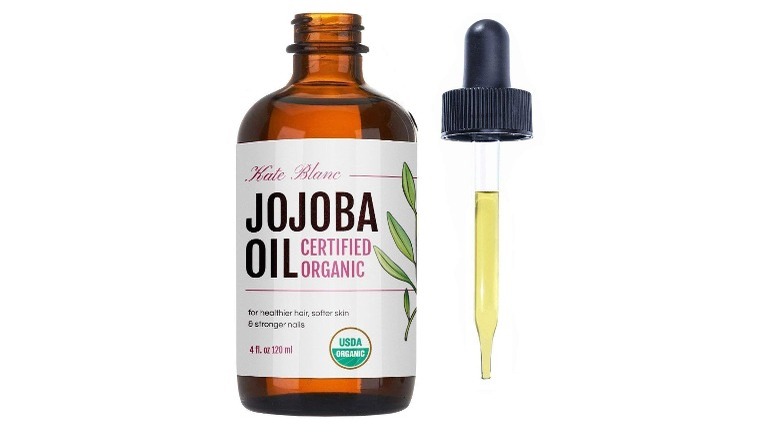Your Guide To Beauty Oils And What They Can & Can't Do For You
We may receive a commission on purchases made from links.
Creating a killer skincare routine is tough. It requires research, patience, and a strong understanding of both your skin and the products available. You can ask your dermatologist for product recommendations, but those are often quite expensive, and not everyone needs medicated or super-strong products. The majority of us are left to our own devices when it comes to skincare, and though it's not an easy road, it's worth taking.
At the heart of every good, basic skincare routine is a great cleanser, moisturizer, and sunscreen. Beyond that, there are infinite routes you can take to procure the complexion of your dreams. If you've read articles about skincare or found a dermatologist to follow on TikTok, you've probably heard someone recommend incorporating beauty oils into your skincare regimen. That advice is solid, but don't go out and buy the first beauty oil you see and expect it to give you an ethereal glow after one use. Oil use and selection are nuanced, and you want to be prudent in your choices. If you need some help, we've got you covered. This is your guide to beauty oils and what they can and can't do for you.
The purpose of beauty oils
Let's start by covering the basics of beauty oils: What are they, and why do so many skincare experts and enthusiasts recommend using them? Beauty oils are oils that we use on our skin made from the extracts of nuts, fruits, seeds, plants, and other natural ingredients that we use for lots of other reasons, like cooking and cleaning. They're easy to find (more on that later) and can be a relatively inexpensive step to add to your skincare routine (so long as you're not purchasing luxury oils, that is). But why exactly are we being told we need to use them?
The short answer: Oils have tons of benefits. They can help with acne, redness, dullness, signs of aging, and more. If you have a skin issue you'd like to address, see if there's an oil that can help with that issue, especially if the issue is mild or you want to address it proactively.
Oils can't solve everything, though, so some issues will need to be taken care of by a dermatologist. However, beauty oils are beneficial for all skin types and are easy to incorporate into your routine. That being said, it's important to know the basics of beauty oils before you jump in and inadvertently cause more skin issues than you solve.
Oils are not moisturizers
Let us be very clear: Oils are not moisturizers. The two products are very different, which is why we're directed to apply them differently and use them for different reasons. They can't be used interchangeably because they don't have the same properties or benefits. Made with water, moisturizers are lotions for your face that hydrate your skin. They're to be used day and night in your skincare routine, and absolutely everyone should be using one. Our faces need lots of hydration no matter our age, the climate, or the time of year, and the best topical product for facial hydration is a moisturizer.
As noted, oils come from natural items like seeds, fruits, plants, and nuts. They do not contain water, and they will not hydrate your face. What oils do, aside from addressing certain skin issues, is create a barrier on your skin. This barrier will lock in moisture and keep it from escaping your face, but it won't actually moisturize your face. Your skin might feel moisturized after you apply beauty oil, especially if you apply it after a moisturizer, but that's because of the barrier it's creating. Oils are preventing moisture loss; they're not hydrating the skin.
How to choose beauty oils
Choosing a beauty oil is as overwhelming as choosing any other skincare product because there are so many options, each with different uses. Think of beauty oils like fruits and vegetables. Just as we're told that carrots are great for eyesight and bananas help with cramps, beauty oils have their own benefits, too. Some help with acne and redness while others are great for anti-aging and dullness. Choose oils according to which skin issue you want to remedy and which work with your skin type. If you have oily skin, you're going to want a different oil than your friend with combination skin.
If you go to a grocery store and visit the health aisles, you'll likely find some oils, like rosehip or tea tree, that can be used on your face. If you go to a beauty store, like Sephora or Ulta, you'll find an assortment of beauty oils similar to the ones at the grocery store, but you'll also find oils that are labeled according to properties, like firming or plumping. You can certainly use the beauty store types, but make sure you read the ingredients, so you know which specific oil is used in the product. For instance, if you have dry skin, and an oil in the ingredients list is meant for oily skin, you may want to select a different product. We'll specify which common oils are good for certain skin types and particular skin issues later on.
How to incorporate beauty oils into your skincare routine
Once you've chosen which beauty oil to use, the next step is incorporating it into your routine, and that can be just as tricky as choosing an oil if you don't have any background knowledge. Before you insert your new oil into your skincare routine at any given point, consider the properties of beauty oil. As noted, beauty oils create a barrier on your skin, and therefore they shouldn't be included at just any step in the skincare process. If you apply oil right after removing your makeup, your skin may not be able to absorb your other products. Oil should almost exclusively be used at the end of your skincare routine.
There's debate over whether oil should be applied before, after, or right along with your moisturizer. Most experts suggest applying oil after moisturizer, but if you find that applying your oil first is beneficial to your skin, continue applying that way. And while some oils can be applied in the morning, most should only be applied at night. It'll likely take some trial and error before you discover what works best for you, but, as always, if you're concerned with your skincare routine or the efficacy of a beauty oil, ask your dermatologist for guidance.
How to apply beauty oils
We realize there are lots of do's and don't's when it comes to beauty oils, and we empathize. But we promise it won't be in vain. Before you start slapping oil onto your face and calling it a night, make sure you know how to properly apply your beauty oil.
Start by dropping one or two drops — you don't need much — of oil directly onto your face if possible. You can use your fingers to apply, but they'll absorb the oil, so it's best to go the other route if you can. To really do its job, the oil needs to absorb into your skin. To ensure absorption, dab the oil into your skin instead of rubbing it around your face. If you're applying other products afterward, like moisturizer, make sure you're letting the oil fully absorb before putting another product on top.
Most oils should be applied at night because they take too long to absorb into the skin, making them a nightmare if you're trying to apply makeup afterward. Others can increase your skin's sensitivity to light, making it difficult to be in the sun. Whenever you're trying a new oil, test it out at night before incorporating it into your morning routine (if you do at all).
Tools to use with your beauty oil
While beauty oil is wonderful to use in your skincare routine on its own, it can also be paired with certain beauty tools to reap further benefits. One beneficial tool to use is a jade roller. Jade rollers can help sculpt your face and reduce fine lines and wrinkles, and it's best to use jade rollers in conjunction with face oil. The oil will help the jade roller roll more smoothly, and in turn, the roller can help massage the oil into your skin. It's a win-win.
Another fabulous tool to use with face oil is a gua sha. Gua shas have similar benefits to jade rollers, and they're also known to help relieve pressure in the face. While jade rollers can be used without oil, gua shas need moisture to help them glide along the skin. The most important characteristic of an oil used with a gua sha is that it promotes gliding.
Since you can wash the oil off your face after you've finished with your jade roller or gua sha, it's not imperative that you choose an oil that definitively suits your skin type, though you can. If you're planning to wash the oil off, just make sure you don't use one that will irritate your skin.
The benefits of maracuja oil
One good oil for the skin is maracuja oil, which comes from the maracuja plant. If you're at all familiar with Tarte products, you know the brand is a major proponent of the oil, and perhaps you've purchased one of its maracuja lip products. Like all oils, maracuja has more benefits than just those for our skin. It's been known to ease anxiety and insomnia, and it's great for your hair. It's used in beauty products because it's great at locking in moisture and has been known to prevent hair loss.
Because it's particularly good for locking in moisture, maracuja oil is recommended for users with dry skin. It'll help keep the skin's moisture barrier intact, aiding in ultra-hydrated skin. Maracuja oil is also great for acne-prone skin since it's non-comedogenic, and it'll help with toning, firming, and brightening. Many users have also found maracuja oil to help chronic skin conditions such as eczema, rosacea, and psoriasis, but if your symptoms of those conditions are severe, consult your dermatologist before using the oil in mitigation efforts.
Because of its benefits, maracuja oil is making its way into more and more beauty products. Unfortunately, it can be rather expensive. But if it's within your budget, it may be a good oil to incorporate into your routine if you have any of the aforementioned skin issues.
What you need to know about tea tree oil
If you've heard of specific beauty oils, you've almost certainly heard of tea tree oil. Tea tree oil is inexpensive (as far as beauty oils go), and it's got a wide range of uses. Tea tree oil comes from the leaves of the Melaleuca alternifolia plant, and it's sometimes called melaleuca oil. It's known to fight fungus and bacteria, which makes it a stellar natural ingredient in beauty products. If you look through the ingredients of your face washes and shampoos, you might find tea tree oil listed.
As far as skincare goes, tea tree oil is great for oily skin, and thanks to its anti-fungal properties, it can be used to fight acne. Again, it's best to consult a dermatologist before using tea tree oil to fight acne, especially if you're already using medicated topical products. But even if you don't have acne, tea tree oil is great to have around for random other uses. It can help your cuts heal faster and remove nail fungus. There's also research that suggests tea tree oil can get rid of and prevent lice. Because of its price and many uses, tea tree is an all-purpose oil that would be wise to have on hand just in case.
How rosehip oil can help you
If you haven't started using rosehip oil, you might want to. Coming from the rosa canina bush, rosehip oil is a gentle oil that's great for sensitive skin. It helps chronic skin conditions like eczema and rosacea, and it's been shown to help with collagen production, which is vital for firm, elastic skin. Because it's basically a super oil, rosehip oil can also be used to fight acne. If you have sensitive skin with a variety of inflammatory conditions, rosehip oil just might be your saving grace.
But don't discount rosehip oil if you don't have sensitive skin or chronic inflammatory conditions. Rosehip oil can also help reverse hyperpigmentation from a variety of culprits like sun damage and hormone changes. It could also potentially aid in protection from UV rays, so depending on how long it takes for your skin to absorb oil, rosehip might work well with your morning skin routine. (If you do incorporate rosehip oil into your morning skincare routine, be sure to continue using sunscreen, as rosehip oil is not a substitute.) Rosehip oil has also been known to fade the appearance of some scars, both acne and surgical. It's got a wide range of benefits.
All about argan oil
Argan oil comes from the kernels of the argan tree. It's great for dry skin, but some experts believe it can benefit all skin types since it's anti-inflammatory and aids in moisturization. The list of its benefits is quite similar to many of the oils we've already discussed: It fights acne, helps your skin heal, and can be used to soothe certain chronic skin conditions such as psoriasis and rosacea. It'll also help your skin maintain a youthful appearance thanks to its anti-aging properties. Unlike some other oils, argan oil has also been shown to both prevent and reduce the appearance of stretch marks.
Argan oil is mostly a super oil but should be used with caution, especially if you've never used it before because it can just as easily exacerbate skin issues as it can soothe them. Argan oil can irritate the skin, especially if you have chronic inflammatory conditions, and it can worsen acne in some users. If you're interested in using argan oil, apply some to a discrete area of your skin to test your sensitivity. If you feel any discomfort or notice skin issues arise in that area hours after application, do not use argan oil on your face.
The magic of marula oil
Coming from the marula fruit tree, marula oil is another beauty oil that you might find as an ingredient in more products than simply skincare. Many people find it to have a lovely scent, making it a great ingredient for lotions and perfumes. Marula oil is anti-inflammatory, anti-aging, non-comedogenic, and has lots of antioxidants. Marula oil also acts similarly to our natural skin oil, so it should be safe for almost anyone to use. If you're worried, just perform the same test mentioned with argan oil to see if you're sensitive to marula oil, or any oil for that matter.
In the great debate over when to apply beauty oils in your skincare routine, marula oil might be the magic oil that can be applied at any step. Marula oil actually helps the skin absorb other products, so don't worry if you accidentally apply it before a serum or two. Marula oil is also a lightweight oil, so you may be able to use it in your morning skincare routine.
What jojoba oil can do for you
Add jojoba oil to the list of magic oils with benefits abounding. It's anti-bacterial, non-comedogenic, and hypoallergenic, and you may just find yourself rubbing jojoba oil onto your entire body. Jojoba oil can help with chronic inflammatory skin conditions, soothe sunburns, heal cuts and cold sores, reduce the appearance of scars, increase collagen production, and more. You can put it on your lips or your cuticles, and it can be used to remove your makeup or alongside your moisturizer. Jojoba oil may protect you from harmful UV rays, and it makes a great hair mask. It can help with dandruff and works as a heat protectant when using hot styling tools on your hair. It's got myriad benefits and uses — you've just got to test it out.
But with any of these oils, make sure you're using them safely and responsibly. Always consult a doctor or dermatologist before use, and don't expect miracles. Beauty oils have wonderful benefits, but they're not cure-alls. Don't abandon other products for a litany of beauty oils: Find one or two that work for you and incorporate them into your existing skincare routine.
